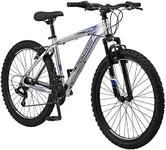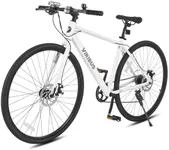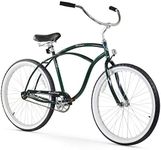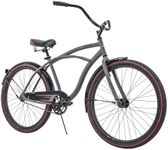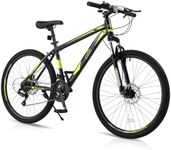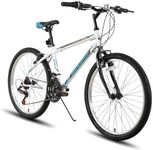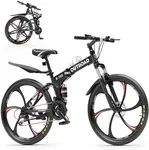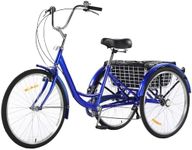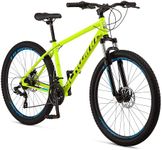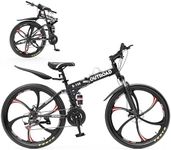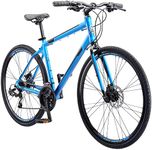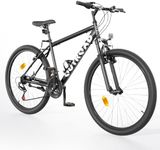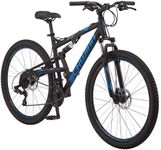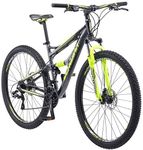Buying Guide for the Best Mens Bikes
Choosing the right men's bike can be a rewarding experience if you know what to look for. The key is to understand your needs and match them with the bike's specifications. Whether you're looking for a bike for commuting, mountain biking, or casual rides, knowing the key specs will help you make an informed decision. Here are the main specifications to consider when selecting a men's bike and how to navigate them to find the best fit for you.Bike TypeThe type of bike is crucial as it determines the bike's design and functionality. Common types include road bikes, mountain bikes, hybrid bikes, and commuter bikes. Road bikes are designed for speed and long-distance rides on paved roads. Mountain bikes are built for off-road trails and rugged terrain. Hybrid bikes offer a mix of road and mountain bike features, making them versatile for various surfaces. Commuter bikes are optimized for daily travel in urban environments. Choose a bike type based on where and how you plan to ride most often.
Frame MaterialThe frame material affects the bike's weight, durability, and ride quality. Common materials include aluminum, carbon fiber, steel, and titanium. Aluminum is lightweight and affordable, making it a popular choice for many riders. Carbon fiber is even lighter and offers excellent vibration dampening, but it is more expensive. Steel is durable and provides a smooth ride, though it is heavier. Titanium combines light weight and durability but comes at a higher cost. Consider your priorities, such as weight, comfort, and budget, when choosing the frame material.
Wheel SizeWheel size impacts the bike's handling and performance. The most common sizes are 26-inch, 27.5-inch, and 29-inch for mountain bikes, and 700c for road and hybrid bikes. Smaller wheels (26-inch) are more agile and easier to maneuver, making them suitable for technical trails. Medium-sized wheels (27.5-inch) offer a balance between agility and stability. Larger wheels (29-inch) provide better traction and roll over obstacles more easily, ideal for long-distance and rough terrain. For road and hybrid bikes, 700c wheels are standard and offer a smooth ride on paved surfaces. Choose a wheel size based on the type of riding you plan to do.
GearingGearing determines how easy or hard it is to pedal the bike in different conditions. Bikes come with a range of gears, from single-speed to multi-speed options. Single-speed bikes are simple and low-maintenance, suitable for flat terrain and short commutes. Multi-speed bikes have multiple gears, allowing you to adjust the resistance for climbing hills or riding fast on flat surfaces. The number of gears can range from a few to over 20. Consider the terrain you'll be riding on and your fitness level when choosing the gearing. More gears provide versatility, while fewer gears offer simplicity.
BrakesBrakes are essential for safety and control. The main types are rim brakes, disc brakes, and coaster brakes. Rim brakes are lightweight and easy to maintain but may be less effective in wet conditions. Disc brakes, available in mechanical and hydraulic versions, offer superior stopping power and performance in all weather conditions. Coaster brakes are found on some cruiser and commuter bikes and are activated by pedaling backward. Choose disc brakes if you need reliable performance in varied conditions, rim brakes for simplicity and light weight, and coaster brakes for casual, low-speed riding.
SuspensionSuspension helps absorb shocks from rough terrain, improving comfort and control. Bikes can have front suspension (hardtail), full suspension, or no suspension (rigid). Hardtail bikes have a suspension fork in the front, making them suitable for cross-country and light trail riding. Full suspension bikes have both front and rear suspension, providing maximum comfort and control on rough and technical trails. Rigid bikes have no suspension and are ideal for smooth surfaces and efficient pedaling. Choose the suspension type based on the terrain you'll be riding and your comfort preferences.
Fit and SizeThe fit and size of the bike are crucial for comfort and performance. Bikes come in various sizes, typically measured by the frame size. A proper fit ensures that you can ride comfortably and efficiently. To find the right size, consider your height and inseam length. Most bike manufacturers provide size charts to help you choose the correct frame size. Additionally, test riding a bike can help you determine if it feels right. A well-fitted bike reduces the risk of injury and enhances your riding experience.
